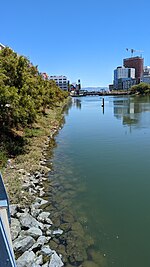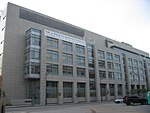UCSF Bakar Cancer Hospital
California hospital stubsCancer hospitalsHospitals in San FranciscoSan Francisco building and structure stubsUniversity of California, San Francisco
UCSF Bakar Cancer Hospital is a cancer hospital in San Francisco, California, part of the University of California, San Francisco health system. It is part of the UCSF Medical Center campus of Mission Bay. Opened on February 1, 2015, part of a $1.5 billion project. It received the highest level of research funding among California cancer centers from the National Cancer Institute.
Excerpt from the Wikipedia article UCSF Bakar Cancer Hospital (License: CC BY-SA 3.0, Authors).UCSF Bakar Cancer Hospital
4th Street, San Francisco
Geographical coordinates (GPS) Address Website Nearby Places Show on map
Geographical coordinates (GPS)
| Latitude | Longitude |
|---|---|
| N 37.766278 ° | E -122.39023 ° |
Address
UCSF Medical Center at Mission Bay
4th Street 1975
94158 San Francisco
California, United States
Open on Google Maps






